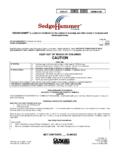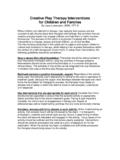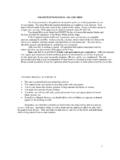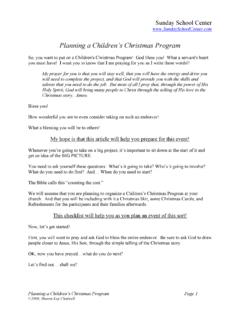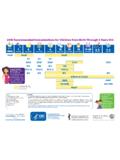Transcription of Treating measles in children - WHO
1 world health OrganizationGeneva2004 updatedWHO/EPI/ (updated 2004)ORIGINAL: ENGLISHDISTR.: GENERALT reatingmeasles inchildrenDEPARTMENT OF IMMUNIZATION, VACCINES AND BIOLOGICALSDEPARTMENT OF CHILD AND ADOLESCENT HEALTHT reating measlesin childrenWorld health OrganizationGeneva2004 updatedWHO/EPI/ (updated 2004)ORIGINAL: ENGLISHDISTR.: GENERALDEPARTMENT OF IMMUNIZATION, VACCINES AND BIOLOGICALSDEPARTMENT OF CHILD AND ADOLESCENT HEALTHThe Department of Immunization, Vaccines and Biologicals thanks the donors whose unspecifi ed/undesignated fi nancial support has made the reproduction of this document production of this CD-ROM teaching aid was made possible a grant from the Micronutrient Initiative, Ottawa, code: WHO/EPI/ : October 1997 (updated 2004)This document and updates of the information contained therein will be regularly posted on the Internet at: may be requested from: world health OrganizationDepartment of Immunization, Vaccines and BiologicalsCH-1211 Geneva 27, Switzerland Fax.
2 : +22 791-4227 E-mail: world health organization 1997 (updated 2004)This document is not a formal publication of the world health organization (WHO), and all rights are reserved by the organization . The document may, however be freely reviewed, abstracted, reproduced and translated, in part or in whole, but not for sale nor for use in conjunction with commercial views expressed in documents by named authors are solely the responsibility of those producing this PowerPoint slide set and booklet, the world health organization (WHO) wishes to acknowledge the contributions made by Dr Nicholas Cohen, formerly with the WHO Expanded Programme on Immunization; Dr Greg Hussey, University of Cape Town, South Africa; Lisa Lee, IHPO, Centers for Disease Control and Prevention, Atlanta, GA, USA and the many others throughout the world who reviewed the early drafts.
3 WHO thanks the following for providing the photographs used:C. J. Clements, N. Cohen, G. Hussey, Teaching Aids at Low Cost (TALC) and the Institute of Child health Library, University of Cape measles IN CHILDREN2 Treating measles IN CHILDRENINTRODUCTION .. 4 Part 1. EPIDEMIOLOGY ..6 Slide 1. Case definition 2. Extent of the problem 1 - Disease and death 3. Extent of the problem 2 - Long-term illness 4. Who gets measles ? 5. Risk factors for severe complicated measles 6. Vitamin A deficiency and severe complicated measles Summary of Part 1 Part 2. NATURAL HISTORY OF measles ..13 Slide7. Clinical course 8. Early rash 9. Rash - day 3 10. Rash - Post- measles staining 11. Rash - Post- measles peeling 12. Complications 13. Long-term complications Summary of Part 2 Part 3. CASE ASSESSMENT AND CLASSIFICATION .. Part 3.
4 CASE ASSESSMENT AND CLASSIFICATION .. Part 3. CASE ASSESSMENT AND CLASSIFICATION .21 Slide 14. Assessment 1 - Assessing severity 15. Assessment 2 - Assessing individual cases 16. Classification 1 - Severe complicated measles 17. Classification 2 - Complicated measles Summary of Part 3 Part 4. Treating COMPLICATIONS .. 26 Slide 18. Where to manage cases 19. General management principles 20. Severe complicated measles - hospital care 1 - Reasons for admission 21. Severe complicated measles - hospital care 2 - Management issues 22. Severe complicated measles - Hospital care 3 - isolation of children 23. Complicated measles - outpatient care 1 - pneumonia 24. Complicated measles - outpatient care 2 - croup 25. Complicated measles - outpatient care 3 - ear problems markermarker3 Treating measles IN children 26. Complicated measles - outpatient care 4 - diarrhoea 27.
5 Complicated measles - outpatient care 5 - eye problems 28. Complicated measles - outpatient care 6 - mouth ulcersSummary of Part 4 Part 5. GENERAL MANAGEMENT ..40 Slide 29. Essential components of management 30. Relieving common symptoms - fever, cough and blocked nose30. Relieving common symptoms - fever, cough and blocked nose30. Relieving common symptoms - f 31. Relieving common symptoms - eye and mouth care 32. Providing nutritional support 33. Giving Vitamin A 34. Vitamin A dosage 35. Informing and advising the mother 36. Reasons for immediate return to clinic Summary of Part 5 Part 6. PREVENTION .. 49 Slide 37. Prevention through immunization 38. Utilizing opportunities for immunization 39. Immunization schedule 40. measles control goalsAppendix A. QUESTIONS FOR USE BY FACILITATORS53 Appendix B. EVALUATION OF measles CASE MANAGEMENT55 Appendix C. DRUG DOSES FOR TREATMENT OF MEASLES564 Treating measles IN CHILDRENINTRODUCTIONThis PowerPoint slide set and booklet contain information for averting deaths from measles and for minimizing the severity of complications of the disease through proper case vaccine is the best public health tool for the prevention of the disease.
6 Despite its extensive use, however, measles cases continue to occur for a variety of reasons. In 2001, the world health organization (WHO) estimated that about 30 million cases and over 700 000 deaths from measles occur annually in developing countries. Most deaths follow complications such as pneumonia, croup and diarrhoea, and are also frequently associated with malnutrition. In addition, measles may result in long-term health problems including blindness, deafness, chronic lung disease, poor growth and recurrent aim of this PowerPoint slide set and booklet is to train health workers in measles case management, with emphasis on how to: identify, assess and classify a case prevent, recognize, treat and manage training in effective measles case management, health workers will correctly identify, assess and treat cases and complications, promote recovery from complications and prevent complications and death.
7 Proper case management of measles should not be seen in isolation but should be complementary to and supportive of other aspects of primary health care for child survival such as: Integrated Management of Childhood Illness. This is a training package for diagnosis and care of children with pneumonia, diarrhoea, malaria, measles and malnutrition, which are the major causes of illness and death in children in developing countries. The Child, measles and the Eye. This CD-ROM training aid describes the prevention and management of measles -related eye disease (WHO/EPI/ ; WHO/ ).5 Treating measles IN CHILDRENT arget audienceThe PowerPoint slide set and booklet are aimed at health workers, particularly those involved in primary health care initiatives such as immunization, nutrition, education or maternal and child health , and their corresponding educational institutions.
8 They will also help health workers in treatment centres and to teachers/facilitatorsIt is recommended that these training materials are used during group teaching sessions. It is good to work and learn within a group, so that everyone can profi t from the experience of others. Allow suffi cient time to look at or read each slide and the accompanying text in the booklet. If desired, the six parts of the slide set can be taught separately. Introduce each part with a general discussion of the health workers current knowledge of measles , and end with a summary of what has been covered during the session. Examples of specifi c questions to facilitate the process are listed in Annex A. Six hours would be a suitable time to allocate to cover teaching the entire 40 slides, although individual needs may alter this time of impact is an essential component of any programme.
9 health workers at the clinic or outpatient level should be involved in evaluating their own programmes at a local level. Annex B provides examples of questions that could assist health workers to set up an evaluation process for their measles case management SlidePART SlideEPIDEMIOLOGY CASE DEFINITIONM easles is an acute childhood infectious disease caused by a virus. The virus is transmitted from person to person through coughing or sneezing. The disease is characterized by: a generalized, reddish (erythematous), blotchy (maculopapular) rash; a history of fever usually above 38 C (if not measured, then "hot" to touch); and at least one of the following - cough, runny nose (coryza), or red eyes (conjunctivitis).In addition, children with measles frequently exhibit a dislike of bright light (photophobia), and often have a sore red mouth (stomatisis).There are many other childhood infectious diseases that also present with a measles -like rash, such as rubella (German measles ) and scarlet fever.
10 However in these diseases cough, coryza or conjunctivitis are usually NOT slide shows a child with the typical measles rash and Slide7 SlidePARTEPIDEMIOLOGY EXTENT OF THE PROBLEM 1 Disease and death30 million measles cases andover 700 000 measlesdeaths annually (2001) measles is a common disease in children . Recent estimates (2001) from WHO indicate that about 30 million cases and 700000 deaths occur annually in developing countries. In these countries, measles is one of the leading causes of childhood deaths, most of which follow complications such as pneumonia, diarrhoea and malnutrition. Actual numbers of children affected by measles may be much higher - health workers often identify a childhood illness as simply "pneumonia" or "diarrhoea" and may not realize that the illness is, in fact, a complication of out how many cases and death from measles occur in your SlidePART SlideEPIDEMIOLOGY EXTENT OF THE PROBLEM 2 Long-term illnessMeasles is associated with long-term health problems.










